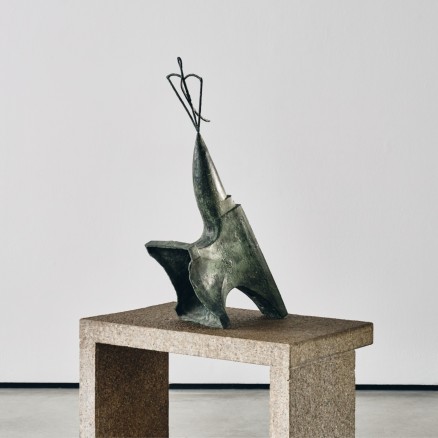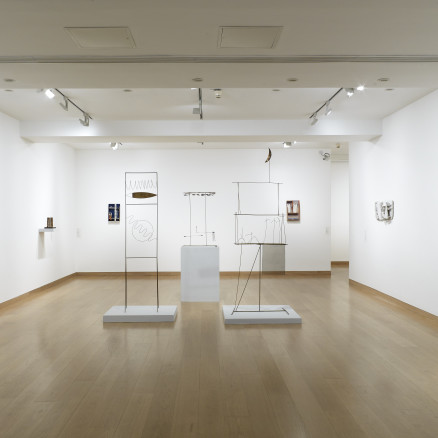Biography
Fausto Melotti (b. 1901, Rovereto, Italy; d. 1986, Milan, Italy) studied physics and mathematics at the Università di Pisa before transferring to Politecnico di Milano to pursue electronic engineering. After completing his military service in 1925, he enrolled briefly at the Accademia di Belle Arte di Brera, Milan, as a pupil of figurative sculptor, Adolfo Wildt, and became close friends with fellow student, Lucio Fontana. Sharing a concern for formal simplicity, light, poetry and spirituality, Melotti collaborated with contemporary rationalist abstract architects, Luigi Figini and Gino Pollini, and exhibited two of his gesso bas-reliefs in their ‘Electric House’ at Monza Triennale in 1930. In 1935, Melotti joined the Abstraction-Création movement founded several years earlier by Theo Van Doesburg, Michel Seuphor and Georges Vantongerloo in Paris, aimed at championing the work of non-figurative artists.
Affected by the war, and the destruction of his Milan studio in an Allied bombing raid in 1943, Melotti began to model terracotta figures and introduced figurative aspects into his sculptures. His ceramic teatrini (‘stage-set’) works, begun in the forties, referenced his admiration for the metaphysical paintings of Giorgio de Chirico. Melotti combined the profound and the whimsical, acknowledging the bittersweet tragicomic aspects of the human condition. As an accomplished pianist and musical theorist, the abstract nature of music can be traced in the lyricism, lightness and quickness of his work. In the 1970s and 1980s, Melotti made free-standing brass and bronze sculptures with explicit references to music, such as ‘Themes and Variations’, and ‘Pavane pour des enfants défunts’ (Pavane for dead children) (1960) after a solo piano piece composed by Maurice Ravel in 1899.
In 1975, A M Hammacher’s major monograph on Melotti was published by Electa, Milan. The same year, Melotti published his own collection of texts and poems entitled Linee (Lines). In 1986, Melotti was post-humously awarded the Golden Lion at the Venice Biennale. Major retrospectives of his work have been held at Museum am Ostwall, Dortmund; Palazzo della Pilotta, Parma; Palazzo Reale, Milan; and Galleria Nazionale d’Arte Moderna, Rome. His work is held in public collections worldwide including Kunstmuseum Bonn; Centro de Arte Reina Sofía, Madrid; Museum of Modern Art, New York; Museum Boijmans Van Beuningen, Rotterdam; Galleria Nazionale d’Arte Moderna, Rome; Museo Civico di Arte Contemporanea, Milan; and Museu Coleção Berardo, Lisbon.
Read moreWorks
-
 Fausto Melotti, Teatrino / Little theatre, c.1950
glazed ceramic, painted terracotta
18 1/8 x 11 7/8 x 3 5/8 in / 46 x 30 x 9 cm
Fausto Melotti, Teatrino / Little theatre, c.1950
glazed ceramic, painted terracotta
18 1/8 x 11 7/8 x 3 5/8 in / 46 x 30 x 9 cm
-
 Fausto Melotti , Evangelista / Evangelist, 1979
brass, copper and plexiglass
62 x 26 x 12 cm
%3Cdiv%20class%3D%22artist%22%3E%3Cspan%20class%3D%22artist%22%3E%3Cstrong%3EFausto%20Melotti%20%3C/strong%3E%3C/span%3E%3C/div%3E%0D%3Cdiv%20class%3D%22title%22%3E%3Cem%3EEvangelista%20/%20Evangelist%3C/em%3E%2C%201979%3C/div%3E%0D%3Cdiv%20class%3D%22medium%22%3Ebrass%2C%20copper%20and%20plexiglass%3C/div%3E%0D%3Cdiv%20class%3D%22dimensions%22%3E62%20x%2026%20x%2012%20cm%3C/div%3E
Fausto Melotti , Evangelista / Evangelist, 1979
brass, copper and plexiglass
62 x 26 x 12 cm
%3Cdiv%20class%3D%22artist%22%3E%3Cspan%20class%3D%22artist%22%3E%3Cstrong%3EFausto%20Melotti%20%3C/strong%3E%3C/span%3E%3C/div%3E%0D%3Cdiv%20class%3D%22title%22%3E%3Cem%3EEvangelista%20/%20Evangelist%3C/em%3E%2C%201979%3C/div%3E%0D%3Cdiv%20class%3D%22medium%22%3Ebrass%2C%20copper%20and%20plexiglass%3C/div%3E%0D%3Cdiv%20class%3D%22dimensions%22%3E62%20x%2026%20x%2012%20cm%3C/div%3E -
 Fausto Melotti, Carro di Tespi / Chariot of Thespis, 1977
brass
43 x 123 x 13.5 cm
Fausto Melotti, Carro di Tespi / Chariot of Thespis, 1977
brass
43 x 123 x 13.5 cm
-
 Fausto Melotti, Le bacche / Berries, 1976
brass
41 x 45 x 20 cm
%3Cdiv%20class%3D%22artist%22%3E%3Cspan%20class%3D%22artist%22%3E%3Cstrong%3EFausto%20Melotti%3C/strong%3E%3C/span%3E%3C/div%3E%0D%3Cdiv%20class%3D%22title%22%3E%3Cem%3ELe%20bacche%20/%20Berries%3C/em%3E%2C%201976%3C/div%3E%0D%3Cdiv%20class%3D%22medium%22%3Ebrass%3C/div%3E%0D%3Cdiv%20class%3D%22dimensions%22%3E41%20x%2045%20x%2020%20cm%3C/div%3E
Fausto Melotti, Le bacche / Berries, 1976
brass
41 x 45 x 20 cm
%3Cdiv%20class%3D%22artist%22%3E%3Cspan%20class%3D%22artist%22%3E%3Cstrong%3EFausto%20Melotti%3C/strong%3E%3C/span%3E%3C/div%3E%0D%3Cdiv%20class%3D%22title%22%3E%3Cem%3ELe%20bacche%20/%20Berries%3C/em%3E%2C%201976%3C/div%3E%0D%3Cdiv%20class%3D%22medium%22%3Ebrass%3C/div%3E%0D%3Cdiv%20class%3D%22dimensions%22%3E41%20x%2045%20x%2020%20cm%3C/div%3E -
 Fausto Melotti, Le Streghe / Witches, 1966
brass
210 x 110 x 110 cm
%3Cdiv%20class%3D%22artist%22%3E%3Cspan%20class%3D%22artist%22%3E%3Cstrong%3EFausto%20Melotti%3C/strong%3E%3C/span%3E%3C/div%3E%0D%3Cdiv%20class%3D%22title%22%3E%3Cem%3ELe%20Streghe%20/%20Witches%3C/em%3E%2C%201966%3C/div%3E%0D%3Cdiv%20class%3D%22medium%22%3Ebrass%3C/div%3E%0D%3Cdiv%20class%3D%22dimensions%22%3E210%20x%20110%20x%20110%20cm%3C/div%3E
Fausto Melotti, Le Streghe / Witches, 1966
brass
210 x 110 x 110 cm
%3Cdiv%20class%3D%22artist%22%3E%3Cspan%20class%3D%22artist%22%3E%3Cstrong%3EFausto%20Melotti%3C/strong%3E%3C/span%3E%3C/div%3E%0D%3Cdiv%20class%3D%22title%22%3E%3Cem%3ELe%20Streghe%20/%20Witches%3C/em%3E%2C%201966%3C/div%3E%0D%3Cdiv%20class%3D%22medium%22%3Ebrass%3C/div%3E%0D%3Cdiv%20class%3D%22dimensions%22%3E210%20x%20110%20x%20110%20cm%3C/div%3E























